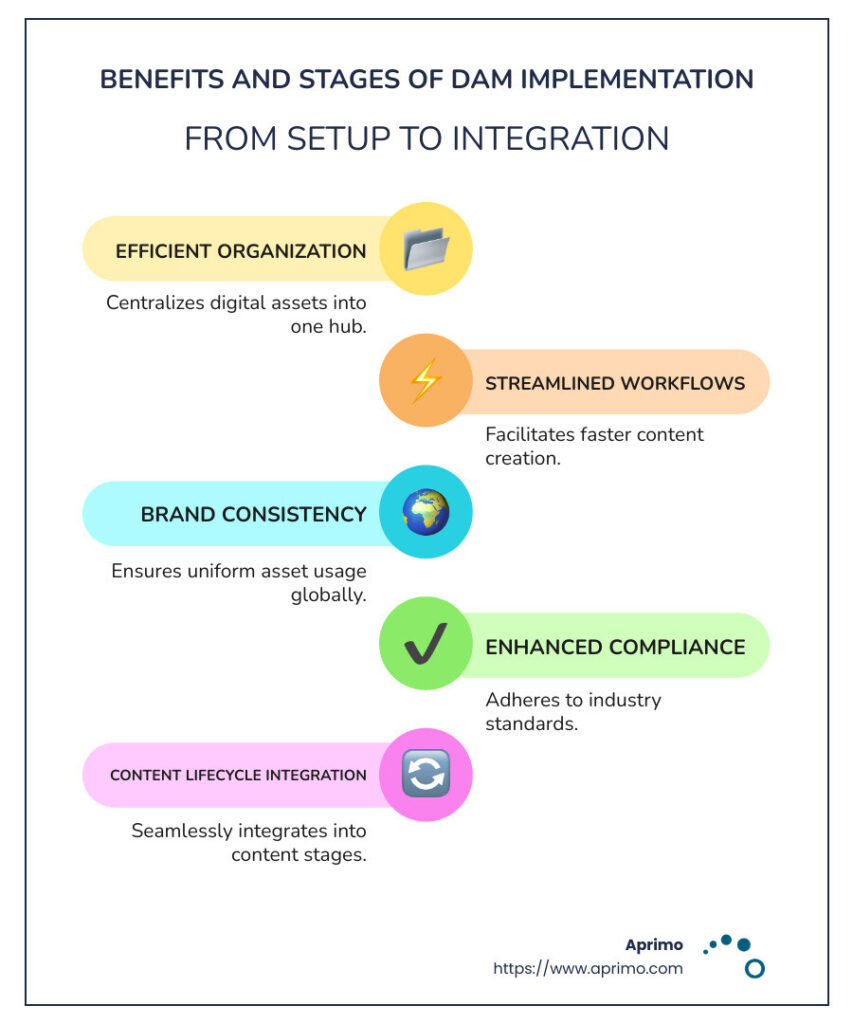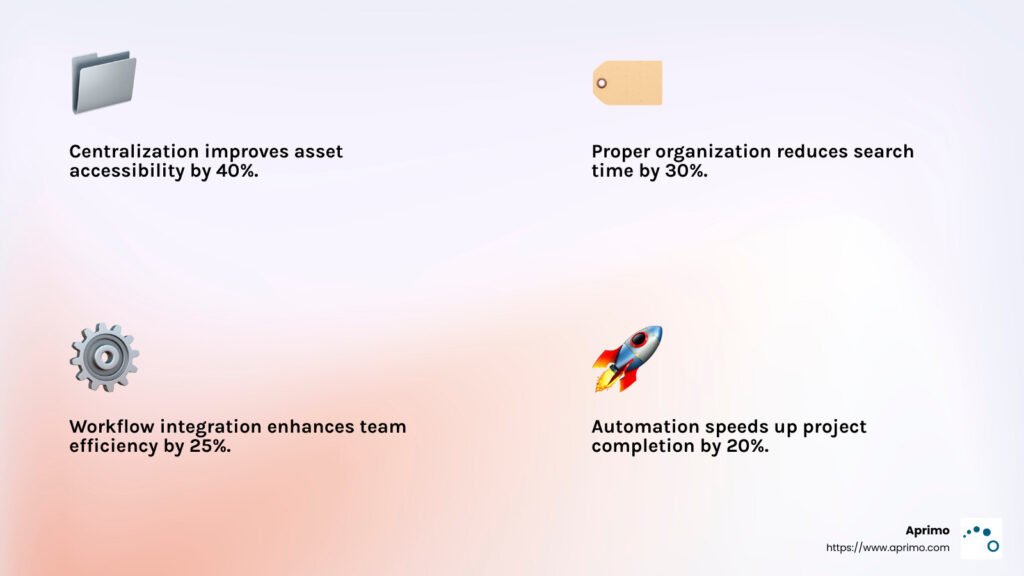DAM implementation—or Digital Asset Management implementation—plays a crucial role in how businesses handle their digital files. It involves the setup of a system that efficiently organizes, stores, and retrieves digital assets like images, videos, and documents. This process improves the control over digital assets and ensures that companies can seamlessly weave their content into various stages of the content lifecycle, boosting productivity and maintaining brand consistency.
As businesses grow and the volume of digital content increases, managing assets becomes more complex and time-consuming. DAM provides a centralized solution that streamlines asset storage, retrieval, and distribution, saving valuable time and reducing the costs associated with content duplication or manual management.
Additionally, companies adopt DAM to maintain brand integrity by ensuring that all teams have access to the most up-to-date, approved assets, which promotes consistency across all marketing channels. With features like automated workflows, version control, and rights management, DAM also minimizes the risk of errors and legal issues, making it a critical tool for modern content-driven organizations.
- Efficient Organization: Streams digital assets into one central hub.
- Streamlined Workflows: Facilitates faster content creation and distribution.
- Brand Consistency: Ensures uniformity in asset usage across global markets.
- Improved Compliance: Helps in adhering to industry standards and regulations.

Start at the End: What are you Really Trying to Achieve With DAM Implementation?
When implementing a DAM system, the ultimate goal is not just to introduce new functionality but to ensure successful adoption across your organization. To achieve this, your DAM must be thoughtfully designed with the user in mind.
First, it needs to be engaging—tailored to fit the user’s specific context and workflows so that it naturally integrates into their day-to-day tasks.
Second, the DAM should be helpful, offering convenience and accessibility to ensure that teams can easily find and use the assets they need, anytime, from any location.
Lastly, it must be instrumental, providing clear advantages over current alternatives, such as improving efficiency, reducing manual work, and enhancing collaboration across teams.
By focusing on these core principles during the initial stages of DAM implementation, you can drive user adoption and unlock the full potential of your system.
Overview of the First Stages of Implementation
Onboarding is the first step in making sure everyone is comfortable with the new Digital Asset Management system. It’s like setting the stage for a play. You must introduce the cast—your team—to their roles and responsibilities. During this stage, you’ll give them access, show them how to use the tools, and explain how the DAM system can make their work easier.
Training is where you dive deeper. It’s not just about knowing which buttons to press. It’s about understanding how the DAM system fits into the bigger picture. Training sessions should be custom to different user groups. For example, marketing teams might need in-depth sessions, while finance teams might only require a high-level overview. Regular refresher courses can help keep skills sharp and ensure everyone is using the system to its full potential.
Integration is crucial for a smooth transition. Make sure all your digital tools communicate and sync with each other. A well-integrated DAM system works seamlessly with existing software, like project management tools or content creation platforms. Digital assets should flow smoothly through the content lifecycle, from creation to distribution.
Digital Rights Management (DRM) is about control. With DRM, you decide who can access what and for how long. Managing digital rights is essential for protecting your assets and ensuring they are used correctly. It also helps in maintaining compliance with industry regulations and standards.
Key Steps for Successful DAM Implementation
Implementing a DAM system can feel like a big project, but breaking it down into key steps makes it manageable. Let’s explore the essential steps for a successful DAM implementation.
Strategic Audit
Organizations must evaluate their current digital asset landscape and identify gaps, inefficiencies, and future needs. A strategic audit involves a thorough examination of existing workflows, asset storage practices, user requirements, and the overall technology stack. By understanding how digital assets are currently managed, accessed, and used, organizations can develop a tailored strategy for deploying a DAM system that aligns with their specific goals.
For example, a retail company might discover during the audit that its marketing and eCommerce teams are spending excessive time searching for product images or re-creating assets that already exist but are hard to find. In this case, the audit would highlight the need for a centralized repository that offers quick asset retrieval and version control, ensuring teams are always working with the most up-to-date visuals.
Similarly, a global manufacturing company might realize that its product documentation is scattered across multiple platforms, making it difficult for regional teams to access the latest technical specifications. The audit could reveal the need for better categorization, metadata tagging, and user permissions so that each region can easily find the assets they need while ensuring proper governance.
Ultimately, the strategic audit phase helps organizations pinpoint the operational challenges they face and design a DAM implementation that resolves these issues and scales with future growth. By taking this comprehensive approach, businesses can ensure a smoother transition and higher adoption rates once the DAM system is in place.
Implementation Plan
A thoughtfully designed implementation plan serves as your roadmap to achieving success with your DAM system.
Start by clearly defining your objectives: What specific problems are you addressing, and what efficiencies do you aim to enhance? Establishing these goals helps keep the project focused and results-driven.
Include a detailed scope statement to avoid scope creep, and ensure you have well-defined, measurable objectives that align with key metrics. Break down the project into phases—such as configuration, testing, and rollout—and set deadlines for each to maintain momentum.
Conduct a thorough risk assessment to identify potential challenges and create contingency plans to mitigate them. To ensure accountability, assign clear roles and responsibilities, and make sure you allocate the necessary resources, both human and technical, to support each phase of the implementation.
By following this structured approach, you can drive successful adoption and long-term value from your DAM system.
Choosing the Right Solution
Choosing the right Digital Asset Management solution is crucial to the success of your implementation. The system you select should align with your organization’s specific needs and long-term goals, as this will directly impact how effectively the DAM is adopted and integrated into your workflows.
Consider your current challenges as identified in the audit phase: Are your teams struggling to find assets quickly? Do you need better collaboration across departments or regions? Identifying these pain points helps you prioritize features that will address your specific business requirements, whether that’s robust search functionality, workflow automation, or detailed version control.
A key consideration when selecting a DAM solution is its scalability. Your organization’s needs may grow over time, whether due to an increasing volume of assets, expanding teams, or entering new markets. A scalable DAM solution will support this growth without requiring a complete overhaul of your system.
Additionally, look for a DAM that integrates seamlessly with your existing tools, such as content management systems (CMS), product information management (PIM) platforms, or creative design software. Your teams should be able to maintain a smooth, efficient workflow and avoid the inefficiencies caused by disconnected systems.
Why Ease of Use Is Essential
The right DAM solution also drives user adoption, which is critical to a successful implementation. If the system is easy to use, intuitive, and fits within your teams’ natural workflow, it’s more likely to be embraced across departments. Consider whether the DAM offers features that make everyday tasks easier, such as drag-and-drop functionality, customizable metadata fields, or automated workflows. A user-friendly interface combined with accessible training resources can help ensure that employees quickly become proficient with the system, accelerating your return on investment.
Choosing the right DAM solution sets the foundation for successful implementation. It impacts everything from how smoothly the system is rolled out to how effectively it supports your business goals in the long term. By carefully assessing your organization’s current and future needs, you can select a DAM that will solve your immediate challenges and provide a scalable, user-friendly platform that empowers your teams while enhancing overall efficiency.
Implementing a DAM: Best Practices to Follow
Implementing a DAM system is a game-changer. It centralizes, organizes, and optimizes workflows, opening up efficiency and creativity.
Centralization
Centralization consolidates all digital assets into a single, accessible repository, ensuring that everyone in the organization works from the same source of truth. This approach eliminates silos, reduces redundancy, and enhances efficiency by making it easier for teams to find, manage, and distribute assets across multiple channels.
With all assets stored in one place, organizations can also implement consistent metadata tagging, version control, and access permissions, which streamlines workflows and safeguards brand consistency and compliance.
Centralization empowers businesses to optimize asset usage while maintaining control and visibility over the entire content lifecycle.
A centralized DAM ensures everyone uses the same approved assets. This consistency strengthens your brand’s identity and messaging.
Organization
A well-organized DAM ensures that digital assets are systematically categorized, tagged, and easily searchable, allowing teams to quickly locate and use the content they need.
Implementing consistent metadata standards, folder structures, and naming conventions helps maintain order within the DAM, preventing chaos as the volume of assets grows. Having consistent organization also improves collaboration across departments, as everyone can access the most up-to-date and approved assets without confusion or duplication of work.
By focusing on structured organization from the start, businesses can streamline workflows, enhance productivity, and maintain greater control over their digital assets, leading to a more efficient content management process.
Workflow Optimization
Workflow optimization enhances the efficiency of how digital assets are created, approved, managed, and distributed. By setting up automated workflows for tasks, teams can reduce the manual effort required to move assets through each stage of their lifecycle.
AI-powered DAM solutions take this a step further by using artificial intelligence to automate repetitive processes, such as tagging assets with relevant metadata, categorizing content, and suggesting approvals based on predefined rules.
With AI-driven insights, organizations can streamline tasks that typically take hours, further optimizing workflows and freeing up valuable time for teams to focus on strategic initiatives.
Optimized workflows also ensure that the right people are involved at the right stages, minimizing bottlenecks and speeding up time to market. By leveraging AI DAM, businesses can achieve greater accuracy, efficiency, and scalability, allowing for faster and more intelligent asset management.

The Ideal DAM Implementation Project Plan
Creating a successful project plan for DAM implementation involves a series of clear and strategic steps. Let’s break it down into manageable parts.
Goal Definition
Defining clear goals before DAM implementation is essential for ensuring that the system aligns with your organization’s specific needs and delivers measurable value. Whether the goals focus on improving asset accessibility, streamlining workflows, or enhancing brand consistency, having these objectives in place guides the selection of the right DAM features and functionality. Having clarity also helps track the system’s success and ensures that teams adopt it effectively, maximizing the return on investment.
Tip: Make your goals specific and measurable. For instance, aim to reduce asset search time by 50% within six months.
Data Migration
Data migration is a critical step. You’ll be moving existing digital assets from old systems into the new DAM, which involves organizing files, cleaning up duplicates, and ensuring all data is transferred accurately.
Best Practice: Develop a data migration strategy that includes naming conventions and metadata standards to help keep your DAM organized from day one.
User Setup
Next, set up user accounts and permissions. Define who needs access to what. This ensures that everyone can find and use the assets they need, without compromising security.
Consider: Different roles might include creators, collaborators, and stakeholders. To streamline workflows, assign permissions based on these roles.
Training
Training is essential for successful DAM adoption. Conduct sessions to teach your team how to use the system effectively. Effective lessons include searching for files, adding new assets, and collaborating with others.
Pro Tip: Tailor training sessions based on user roles. For marketing teams, focus on how the DAM can streamline asset creation, collaboration, and distribution across various channels, emphasizing features like automated workflows, metadata tagging for quick asset retrieval, and version control to ensure brand consistency. For finance teams, the training should highlight how the DAM helps with tracking asset usage, rights management, and compliance, showing them how to access relevant reports and ensure proper licensing.
Testing
Before going live, test the DAM system thoroughly. This involves checking for bugs, ensuring integrations work smoothly, and gathering user feedback. Testing helps identify issues early, saving time and headaches later.
Remember: Testing is not a one-time event. Schedule regular feedback sessions to continually refine the system.
By following these steps, you can create a robust project plan for DAM implementation. A structured approach will set your organization up for long-term success.
How long does it take to implement a DAM?
The timeline for implementing a DAM system typically ranges from a few weeks to several months, depending on the complexity of the organization’s needs, the volume of digital assets, and the level of customization required.
For smaller businesses with straightforward asset management requirements, implementation might take as little as four to six weeks, focusing on configuration, basic training, and initial asset migration. However, for larger enterprises with more complex workflows, integrations with other systems, and extensive asset libraries, the process can take three to six months or more.
When calculating your timeline, include phases like strategic auditing, customization, testing, staff training, and full deployment. A well-planned approach, with clear goals and roles, helps ensure timely and successful implementation.
Achieving Success: Key Takeaways for Effective DAM Implementation
AI-powered content operations are changing how organizations manage their digital assets. By leveraging advanced AI capabilities, we can accelerate content creation, improve asset findability, and automate asset management. Organizations that successfully implement a new DAM system achieve boosted productivity and ensure that their content remains relevant and engaging.
Brand governance is another critical aspect of DAM implementation. A well-structured DAM system helps maintain a consistent brand identity across all channels. By centralizing approved brand assets like logos and templates, companies can ensure that every piece of content aligns with their brand guidelines. Consistency is crucial for building trust and recognition among diverse audiences.
Implementing a DAM system is about creating a strategic framework that supports a brand’s growth and innovation. With AI-powered tools, organizations can optimize workflows and make data-driven decisions that improve their content strategies.
DAM implementation is a powerful way to streamline your content lifecycle and uphold strong brand governance. By adopting these best practices, organizations can open up the full potential of their digital assets and drive long-term success.
Aprimo simplifies implementation by offering a flexible, scalable platform that seamlessly integrates with existing workflows and systems, helping organizations streamline asset management and improve collaboration. With intuitive tools, automation capabilities, and expert support, Aprimo ensures a smooth rollout tailored to your specific business needs. Book a demo today to transform your digital asset management.


